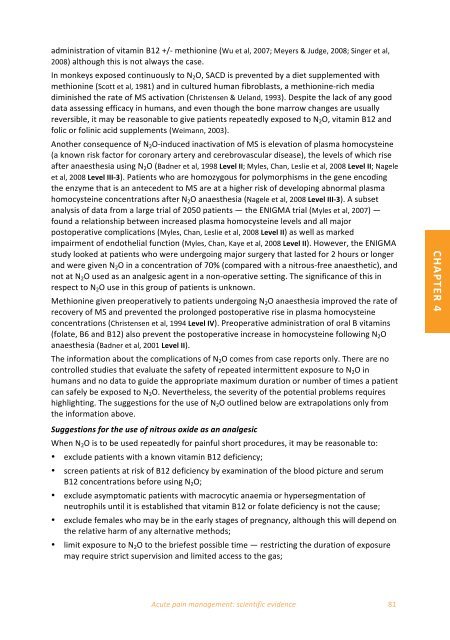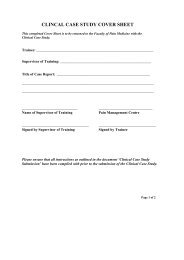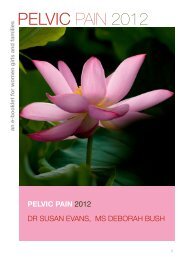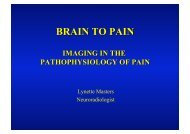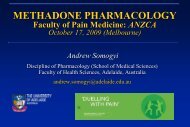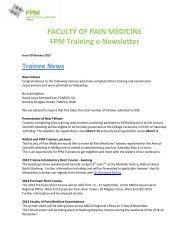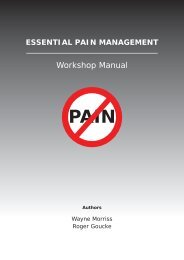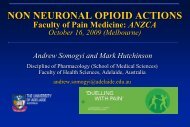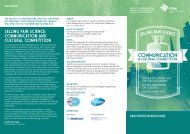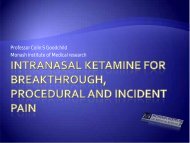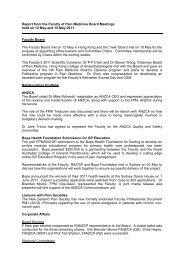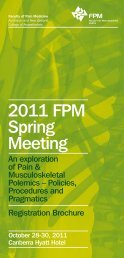Acute Pain - final version - Faculty of pain medicine - Australian and ...
Acute Pain - final version - Faculty of pain medicine - Australian and ...
Acute Pain - final version - Faculty of pain medicine - Australian and ...
Create successful ePaper yourself
Turn your PDF publications into a flip-book with our unique Google optimized e-Paper software.
<br />
<br />
administration <strong>of</strong> vitamin B12 +/‐ methionine (Wu et al, 2007; Meyers & Judge, 2008; Singer et al, <br />
2008) although this is not always the case. <br />
In monkeys exposed continuously to N 2 O, SACD is prevented by a diet supplemented with <br />
methionine (Scott et al, 1981) <strong>and</strong> in cultured human fibroblasts, a methionine‐rich media <br />
diminished the rate <strong>of</strong> MS activation (Christensen & Uel<strong>and</strong>, 1993). Despite the lack <strong>of</strong> any good <br />
data assessing efficacy in humans, <strong>and</strong> even though the bone marrow changes are usually <br />
reversible, it may be reasonable to give patients repeatedly exposed to N 2 O, vitamin B12 <strong>and</strong> <br />
folic or folinic acid supplements (Weimann, 2003). <br />
Another consequence <strong>of</strong> N 2 O‐induced inactivation <strong>of</strong> MS is elevation <strong>of</strong> plasma homocysteine <br />
(a known risk factor for coronary artery <strong>and</strong> cerebrovascular disease), the levels <strong>of</strong> which rise <br />
after anaesthesia using N 2 O (Badner et al, 1998 Level II; Myles, Chan, Leslie et al, 2008 Level II; Nagele <br />
et al, 2008 Level III‐3). Patients who are homozygous for polymorphisms in the gene encoding <br />
the enzyme that is an antecedent to MS are at a higher risk <strong>of</strong> developing abnormal plasma <br />
homocysteine concentrations after N 2 O anaesthesia (Nagele et al, 2008 Level III‐3). A subset <br />
analysis <strong>of</strong> data from a large trial <strong>of</strong> 2050 patients — the ENIGMA trial (Myles et al, 2007) — <br />
found a relationship between increased plasma homocysteine levels <strong>and</strong> all major <br />
postoperative complications (Myles, Chan, Leslie et al, 2008 Level II) as well as marked <br />
impairment <strong>of</strong> endothelial function (Myles, Chan, Kaye et al, 2008 Level II). However, the ENIGMA <br />
study looked at patients who were undergoing major surgery that lasted for 2 hours or longer <br />
<strong>and</strong> were given N 2 O in a concentration <strong>of</strong> 70% (compared with a nitrous‐free anaesthetic), <strong>and</strong> <br />
not at N 2 O used as an analgesic agent in a non‐operative setting. The significance <strong>of</strong> this in <br />
respect to N 2 O use in this group <strong>of</strong> patients is unknown. <br />
Methionine given preoperatively to patients undergoing N 2 O anaesthesia improved the rate <strong>of</strong> <br />
recovery <strong>of</strong> MS <strong>and</strong> prevented the prolonged postoperative rise in plasma homocysteine <br />
concentrations (Christensen et al, 1994 Level IV). Preoperative administration <strong>of</strong> oral B vitamins <br />
(folate, B6 <strong>and</strong> B12) also prevent the postoperative increase in homocysteine following N 2 O <br />
anaesthesia (Badner et al, 2001 Level II). <br />
The information about the complications <strong>of</strong> N 2 O comes from case reports only. There are no <br />
controlled studies that evaluate the safety <strong>of</strong> repeated intermittent exposure to N 2 O in <br />
humans <strong>and</strong> no data to guide the appropriate maximum duration or number <strong>of</strong> times a patient <br />
can safely be exposed to N 2 O. Nevertheless, the severity <strong>of</strong> the potential problems requires <br />
highlighting. The suggestions for the use <strong>of</strong> N 2 O outlined below are extrapolations only from <br />
the information above. <br />
Suggestions for the use <strong>of</strong> nitrous oxide as an analgesic <br />
When N 2 O is to be used repeatedly for <strong>pain</strong>ful short procedures, it may be reasonable to: <br />
• exclude patients with a known vitamin B12 deficiency; <br />
• screen patients at risk <strong>of</strong> B12 deficiency by examination <strong>of</strong> the blood picture <strong>and</strong> serum <br />
B12 concentrations before using N 2 O; <br />
• exclude asymptomatic patients with macrocytic anaemia or hypersegmentation <strong>of</strong> <br />
neutrophils until it is established that vitamin B12 or folate deficiency is not the cause; <br />
• exclude females who may be in the early stages <strong>of</strong> pregnancy, although this will depend on <br />
the relative harm <strong>of</strong> any alternative methods; <br />
• limit exposure to N 2 O to the briefest possible time — restricting the duration <strong>of</strong> exposure <br />
may require strict supervision <strong>and</strong> limited access to the gas; <br />
CHAPTER 4 <br />
<strong>Acute</strong> <strong>pain</strong> management: scientific evidence 81


